Modeling Extreme Water Levels in the Salish Sea: The Importance of Including Remote Sea Level Anomalies for Application in Hydrodynamic Simulations
Abstract
:1. Introduction
Study Area
2. Materials and Methods
2.1. Model and Data Sources
2.2. Model Approach
2.3. Analysis Methods
2.4. Development of Sea Level Anomaly Predictor
3. Results
3.1. Model Skill: Tides and Storm Surge Propagation, Water Level Gradient
3.2. Sea Level Anomaly Predictor
3.3. Extreme Water Level Recurrence and Change
3.4. Contribution of SLA to Extreme Water Levels
4. Discussion
5. Conclusions
Author Contributions
Funding
Data Availability Statement
Acknowledgments
Conflicts of Interest
Appendix A
Appendix A.1. Stream Discharge Multi-Linear Regression Gap-Filling


Appendix A.2. Meteorological Bias Correction
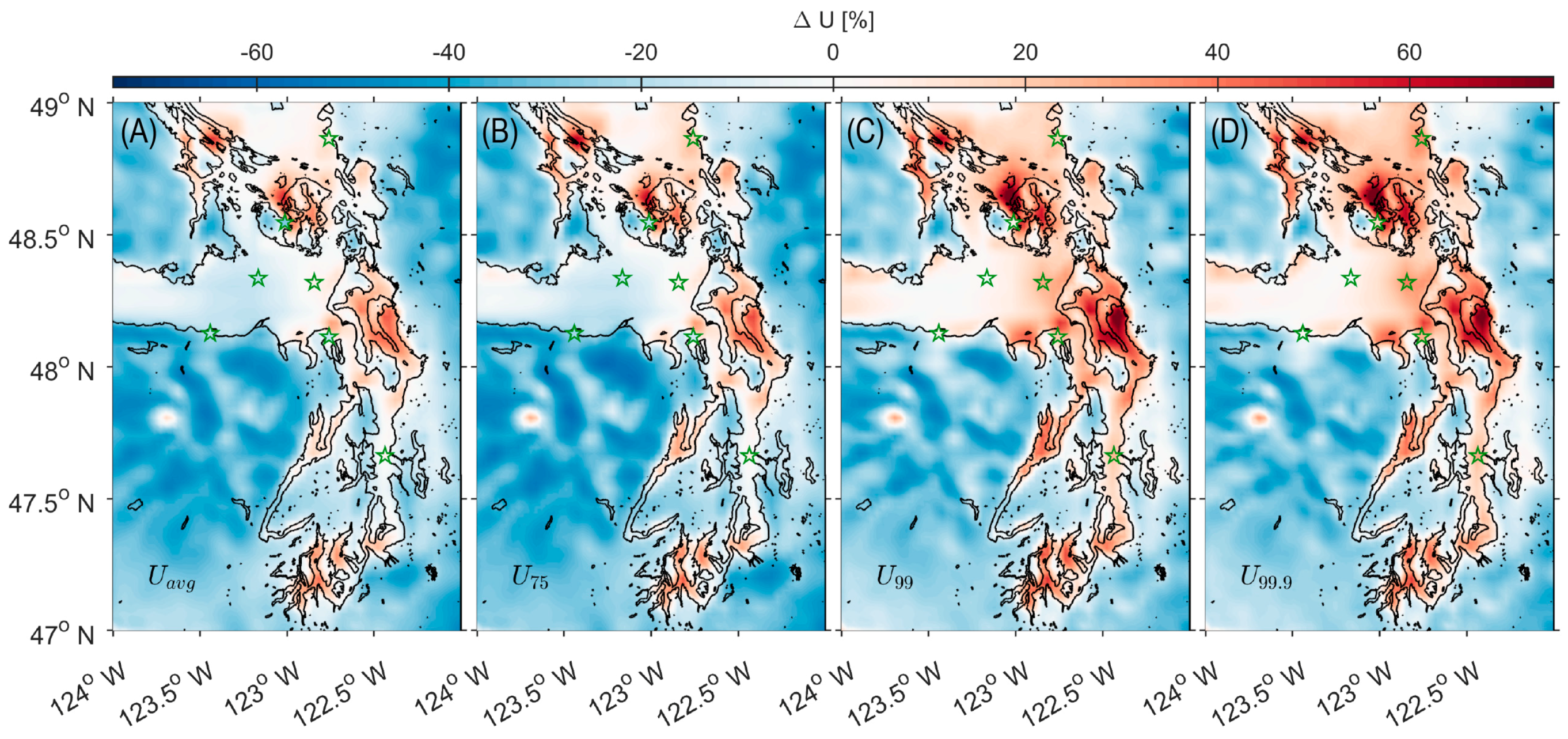
| Name | ID | L |
|---|---|---|
| Hein Bank | 46088 | 0.1 |
| Port Townsend | PTWW1 | 0.01 |
| Port Angeles | PTAW1 | 0.1 |
| Friday Harbor | FRDW1 | 0.01 |
| Smith Island | SISW1 | 0.1 |
| West Point | WPOW1 | 0.15 |
| Neah Bay | 46087 | 0.01 |
| Cherry Point | CHYW1 | 0.1 |
References
- Sweet, W.V.; Park, J. From the extreme to the mean: Acceleration and tipping points of coastal inundation from sea-level rise. Earth’s Future 2014, 2, 579–600. [Google Scholar] [CrossRef]
- Vitousek, S.; Barnard, P.L.; Fletcher, C.H.; Frazer, N.; Erikson, L.; Storlazzi, C.D. Doubling of coastal flooding frequency within decades due to sea-level rise. Sci. Rep. 2017, 7, 1399. [Google Scholar] [CrossRef] [PubMed]
- Taherkhani, M.; Vitousek, S.; Barnard, P.L.; Frazer, N.; Anderson, T.R.; Fletcher, C.H. Sea-level rise exponentially increases coastal flood frequency. Sci. Rep. 2020, 10, 6466. [Google Scholar] [CrossRef] [PubMed]
- Sweet, W.V.; Hamlington, B.D.; Kopp, R.E.; Weaver, C.P.; Barnard, P.L.; Bekaert, D.; Brooks, W.; Craghan, M.; Dusek, G.; Frederikse, T.; et al. Global and Regional Sea Level Rise Scenarios for the United States: Updated Mean Projections and Extreme Water Level Probabilities Along U.S. Coastlines; NOAA Technical Report NOS 01; National Oceanic and Atmospheric Administration, National Ocean Service: Silver Spring, MD, USA, 2022; 111p, Available online: https://oceanservice.noaa.gov/hazards/sealevelrise/noaa-nos-techrpt01-global-regional-SLR-scenarios-US.pdf (accessed on 15 February 2023).
- Guérou, A.; Meyssignac, B.; Prandi, P.; Ablain, M.; Ribes, A.; Bignalet-Cazalet, F. Current Observed Global Mean Sea Level Rise and Acceleration Estimated from Satellite Altimetry and the Associated Uncertainty. EGUsphere 2022, 19, 431–451. [Google Scholar] [CrossRef]
- Vermeer, M.; Rahmstorf, S. Global sea level linked to global temperature. Proc. Natl. Acad. Sci. USA 2009, 106, 21527–21532. [Google Scholar] [CrossRef] [PubMed]
- Church, J.A.; White, N.J. Sea-Level Rise from the Late 19th to the Early 21st Century. Surv. Geophys. 2011, 32, 585–602. [Google Scholar] [CrossRef]
- Leuliette, E.; Willis, J. Balancing the Sea Level Budget. Oceanography 2011, 24, 122–129. [Google Scholar] [CrossRef]
- Hay, C.C.; Morrow, E.; Kopp, R.E.; Mitrovica, J.X. Probabilistic reanalysis of twentieth-century sea-level rise. Nature 2015, 517, 481–484. [Google Scholar] [CrossRef]
- Barnard, P.L.; Erikson, L.H.; Foxgrover, A.C.; Hart, J.A.F.; Limber, P.; O’neill, A.C.; van Ormondt, M.; Vitousek, S.; Wood, N.; Hayden, M.K.; et al. Dynamic flood modeling essential to assess the coastal impacts of climate change. Sci. Rep. 2019, 9, 4309. [Google Scholar] [CrossRef]
- Erikson, L.; Hegermiller, C.; Barnard, P.; Ruggiero, P.; van Ormondt, M. Projected wave conditions in the Eastern North Pacific under the influence of two CMIP5 climate scenarios. Ocean Model. 2015, 96, 171–185. [Google Scholar] [CrossRef]
- Wahl, T.; Jain, S.; Bender, J.; Meyers, S.D.; Luther, M.E. Increasing risk of compound flooding from storm surge and rainfall for major US cities. Nat. Clim. Chang. 2015, 5, 1093–1097. [Google Scholar] [CrossRef]
- Zscheischler, J.; Westra, S.; Van Den Hurk, B.J.J.M.; Seneviratne, S.I.; Ward, P.J.; Pitman, A.; AghaKouchak, A.; Bresch, D.N.; Leonard, M.; Wahl, T.; et al. Future climate risk from compound events. Nat. Clim. Chang. 2018, 8, 469–477. [Google Scholar] [CrossRef]
- Bromirski, P.D.; Miller, A.J.; Flick, R.E.; Auad, G. Dynamical suppression of sea level rise along the Pacific coast of North America: Indications for imminent acceleration. J. Geophys. Res. Atmos. 2011, 116, C07005. [Google Scholar] [CrossRef]
- Tehranirad, B.; Herdman, L.; Nederhoff, K.; Erikson, L.; Cifelli, R.; Pratt, G.; Leon, M.; Barnard, P. Effect of Fluvial Discharges and Remote Non-Tidal Residuals on Compound Flood Forecasting in San Francisco Bay. Water 2020, 12, 2481. [Google Scholar] [CrossRef]
- Nederhoff, K.; Saleh, R.; Tehranirad, B.; Herdman, L.; Erikson, L.; Barnard, P.L.; Van der Wegen, M. Drivers of extreme water levels in a large, urban, high-energy coastal estuary–a case study of the san francisco bay. Coast. Eng. 2021, 170, 103984. [Google Scholar] [CrossRef]
- Morey, S.L.; Baig, S.; Bourassa, M.A.; Dukhovskoy, D.S.; O’Brien, J.J. Remote forcing contribution to storm-induced sea level rise during Hurricane Dennis. Geophys. Res. Lett. 2006, 33, L19603. [Google Scholar] [CrossRef]
- Zhong, L.; Li, M.; Zhang, D.L. How do uncertainties in hurricane model forecasts affect storm surge predictions in a semi-enclosed bay? Estuar. Coast Shelf Sci. 2010, 90, 61–72. [Google Scholar] [CrossRef]
- Liu, X.; Jiang, W.; Yang, B.; Baugh, J. Numerical study on factors influencing typhoon-induced storm surge distribution in Zhanjiang Harbor. Estuar. Coast Shelf Sci. 2018, 215, 39–51. [Google Scholar] [CrossRef]
- Durski, S.M.; Kurapov, A.L.; Allen, J.S.; Kosro, P.M.; Egbert, G.D.; Shearman, R.K.; Barth, J.A. Coastal ocean variability in the US Pacific Northwest region: Seasonal patterns, winter circulation, and the influence of the 2009–2010 El Niño. Ocean Dyn. 2015, 65, 1643–1663. [Google Scholar] [CrossRef]
- Hamlington, B.D.; Leben, R.R.; Kim, K.; Nerem, R.S.; Atkinson, L.P.; Thompson, P.R. The effect of the El Niño-Southern Oscillation on U.S. regional and coastal sea level. J. Geophys. Res. Oceans 2015, 120, 3970–3986. [Google Scholar] [CrossRef]
- Kurapov, A.; Pelland, N.; Rudnick, D. Seasonal and interannual variability in along-slope oceanic properties off the us west coast: Inferences from a high-resolution regional model. J. Geophys. Res. Oceans 2017, 122, 5237–5259. [Google Scholar] [CrossRef]
- MacMahan, J. Observations of oceanic-forced subtidal elevations in a convergent estuary. Estuar. Coast Shelf Sci. 2016, 181, 319–324. [Google Scholar] [CrossRef]
- Murty, T.; Venkatesh, S.; Danard, M.; El-Sabh, M. Storm surges in Canadian waters. Atmosphere-Ocean 1995, 33, 359–387. [Google Scholar] [CrossRef]
- Thompson, P.R.; Merrifield, M.A.; Wells, J.R.; Chang, C.M. Wind-Driven Coastal Sea Level Variability in the Northeast Pacific. J. Clim. 2014, 27, 4733–4751. [Google Scholar] [CrossRef]
- Barnard, P.L.; Short, A.D.; Harley, M.D.; Splinter, K.D.; Vitousek, S.; Turner, I.L.; Allan, J.; Banno, M.; Bryan, K.R.; Doria, A.; et al. Coastal vulnerability across the Pacific dominated by El Niño/Southern Oscillation. Nat. Geosci. 2015, 8, 801–807. [Google Scholar] [CrossRef]
- Barnard, P.L.; Hoover, D.; Hubbard, D.M.; Snyder, A.; Ludka, B.C.; Allan, J.; Kaminsky, G.M.; Ruggiero, P.; Gallien, T.W.; Gabel, L.; et al. Extreme oceanographic forcing and coastal response due to the 2015–2016 El Niño. Nat. Commun. 2017, 8, 14365. [Google Scholar] [CrossRef]
- Flick, R.E. California tides, sea level, and waves—Winter 2015–2016. Shore Beach 2016, 84, 25–30. [Google Scholar]
- Soontiens, N.; Allen, S.E.; Latornell, D.; Le Souëf, K.; Machuca, I.; Paquin, J.-P.; Lu, Y.; Thompson, K.; Korabel, V. Storm Surges in the Strait of Georgia Simulated with a Regional Model. Atmosphere-Ocean 2015, 54, 1–21. [Google Scholar] [CrossRef]
- Vos, K.; Harley, M.D.; Turner, I.L.; Splinter, K.D. Pacific shoreline erosion and accretion patterns controlled by El Niño/Southern Oscillation. Nat. Geosci. 2023, 16, 140–146. [Google Scholar] [CrossRef]
- Muis, S.; Apecechea, M.I.; Dullaart, J.; Rego, J.d.L.; Madsen, K.S.; Su, J.; Yan, K.; Verlaan, M. A High-Resolution Global Dataset of Extreme Sea Levels, Tides, and Storm Surges, Including Future Projections. Front. Mar. Sci. 2020, 7, 263. [Google Scholar] [CrossRef]
- Chassignet, E.P.; Hurlburt, H.E.; Smedstad, O.M.; Halliwell, G.R.; Hogan, P.J.; Wallcraft, A.J.; Baraille, R.; Bleck, R. The HYCOM (HYbrid Coordinate Ocean Model) data assimilative system. J. Mar. Syst. 2007, 65, 60–83. [Google Scholar] [CrossRef]
- Yang, Z.; Wang, T.; Castrucci, L. Storm Surge Modeling in Puget Sound. Technical Report. Pacific Northwest National Lab (PNNL), Richland, WA (United States). 2019. Available online: https://www.osti.gov/servlets/purl/1558622 (accessed on 15 May 2020).
- Mass, C.F.; Salath’e Jr, E.P.; Steed, R.; Baars, J. The mesoscale response to global warming over the pacific northwest evaluated using a regional climate model ensemble. J. Clim. 2022, 35, 2035–2053. [Google Scholar] [CrossRef]
- Sobocinski, K.L. State of the Salish Sea. G. Broadhurst and N.J.K. Baloy (Contributing Eds.). Salish Sea Institute, Western Washington University. 2021. Available online: https://cedar.wwu.edu/salish_pubs/1/ (accessed on 1 February 2022).
- Steenburgh, W.J.; Mass, C.F. Interaction of an Intense Extratropical Cyclone with Coastal Orography. Mon. Weather Rev. 1996, 124, 1329–1352. [Google Scholar] [CrossRef]
- Martin, J.E.; Grauman, R.D.; Marsili, N. Surface Cyclolysis in the North Pacific Ocean. Part I: A Synoptic Climatology. Mon. Weather Rev. 2001, 129, 748–765. [Google Scholar] [CrossRef]
- Eichler, T.; Higgins, W. Climatology and ENSO-Related Variability of North American Extratropical Cyclone Activity. J. Clim. 2006, 19, 2076–2093. [Google Scholar] [CrossRef]
- Abeysirigunawardena, D.S.; Gilleland, E.; Bronaugh, D.; Wong, P. Extreme wind regime responses to climate variability and change in the inner south coast of British Columbia, Canada. Atmosphere-Ocean 2009, 47, 41–62. [Google Scholar] [CrossRef]
- Grossman, E.; Stevens, A.; Dartnell, P.; George, D.; Finlayson, D. Sediment export and impacts associated with river delta channelization compound estuary vulnerability to sea-level rise, Skagit River Delta, Washington, USA. Mar. Geol. 2020, 430, 106336. [Google Scholar] [CrossRef]
- Hanna, J.M. Native Communities and Climate Change: Protecting Tribal Resources as Part of National Climate Policy; Natural Resources Law Center, University of Colorado Law School: Boulder, CO, USA, 1997. [Google Scholar]
- Status of Tribes and Climate Change Working Group. Status of Tribes and Climate Change Report; Marks-Marino, D., Ed.; Institute for Tribal Environmental Professionals, Northern Arizona University: Flagstaff, AZ, USA, 2021; Available online: http://nau.edu/stacc 2021 (accessed on 22 November 2023).
- Mofjeld, H.O.; Larsen, L.H. Tides and Tidal Currents of the Inland Waters of Western Washington; NOAA Technical Memorandum ERL PMEL-56; National Oceanic and Atmospheric Administration: Washington, DC, USA, 1984. [Google Scholar]
- Lavelle, J.W.; Cokelet, E.D.; Cannon, G.A. A model study of density intrusions into and circulation within a deep, silled estuary: Puget Sound. J. Geophys. Res. Atmos. 1991, 96, 16779. [Google Scholar] [CrossRef]
- Babson, A.L.; Kawase, M.; MacCready, P. Seasonal and Interannual Variability in the Circulation of Puget Sound, Washington: A Box Model Study. Atmosphere-Ocean 2006, 44, 29–45. [Google Scholar] [CrossRef]
- Yang, Z.; Khangaonkar, T. Multi-scale modeling of Puget Sound using an unstructured-grid coastal ocean model: From tide flats to estuaries and coastal waters. Ocean Dyn. 2010, 60, 1621–1637. [Google Scholar] [CrossRef]
- Sutherland, D.A.; MacCready, P.; Banas, N.S.; Smedstad, L.F. A Model Study of the Salish Sea Estuarine Circulation. J. Phys. Oceanogr. 2011, 41, 1125–1143. [Google Scholar] [CrossRef]
- Abeysirigunawardena, D.S.; Smith, D.J.; Taylor, B. Extreme Sea Surge Responses to Climate Variability in Coastal British Columbia, Canada. Ann. Assoc. Am. Geogr. 2011, 101, 992–1010. [Google Scholar] [CrossRef]
- Yang, Z.; Wang, T. Tidal residual eddies and their effect on water exchange in Puget Sound. Ocean Dyn. 2013, 63, 995–1009. [Google Scholar] [CrossRef]
- Yang, Z.; Wang, T.; Leung, R.; Hibbard, K.; Janetos, T.; Kraucunas, I.; Rice, J.; Preston, B.; Wilbanks, T. A modeling study of coastal inundation induced by storm surge, sea-level rise, and subsidence in the Gulf of Mexico. Nat. Hazards 2013, 71, 1771–1794. [Google Scholar] [CrossRef]
- Yang, Z.; Wang, T.; Voisin, N.; Copping, A. Estuarine response to river flow and sea-level rise under future climate change and human development. Estuar. Coast Shelf Sci. 2015, 156, 19–30. [Google Scholar] [CrossRef]
- Khangaonkar, T.; Long, W.; Xu, W. Assessment of circulation and inter-basin transport in the Salish Sea including Johnstone Strait and Discovery Islands pathways. Ocean Model. 2017, 109, 11–32. [Google Scholar] [CrossRef]
- Miller, I.M.; Morgan, H.; Mauger, G.; Newton, T.; Weldon, R.; Schmidt, D.; Welch, M.; Grossman, E.E. Projected Sea Level Rise for Washington State—A 2018 Assessment: Prepared for the Washington Coastal Resilience Project. 2018. 24p. Available online: http://www.wacoastalnetwork.com/files/theme/wcrp/SLR-Report-Miller-et-al-2018.pdf (accessed on 22 November 2023).
- Yang, Z.; Wang, T.; Castrucci, L.; Miller, I. Modeling assessment of storm surge in the Salish Sea. Estuar. Coast Shelf Sci. 2019, 238, 106552. [Google Scholar] [CrossRef]
- Bromirski, P.D.; Flick, R.E.; Miller, A.J. Storm surge along the Pacific coast of North America. J. Geophys. Res. Oceans 2017, 122, 441–457. [Google Scholar] [CrossRef]
- Kernkamp, H.W.; Van Dam, A.; Stelling, G.S.; de Goede, E.D. Efficient scheme for the shallow water equations on unstructured grids with application to the continental shelf. Ocean Dyn. 2011, 61, 1175–1188. [Google Scholar] [CrossRef]
- Tyler, D.J.; Danielson, J.J.; Grossman, E.E.; Hockenberry, R.J. Topobathymetric Model of the Strait of Juan de Fuca, 1891 to 2016: U.S. Geological Survey Data Release. 2021. Available online: https://www.sciencebase.gov/catalog/item/5d7641bee4b0c4f70d01f564 (accessed on 22 November 2023).
- Tyler, D.J.; Danielson, J.J.; Grossman, E.E.; Hockenberry, R.J. Topobathymetric Model of Puget Sound, Washington, 1887 to 2017; U.S. Geological Survey: Reston, VA, USA, 2020. [Google Scholar] [CrossRef]
- Carignan, K.; Eakins, B.; Love, M.; Sutherland, M.; McLean, S. Bathymetric Digital Elevation Model of British Columbia, Canada: Procedures, Data Sources, and Analysis. NOAA National Geophysical Data Center (NGDC). 2013. Available online: https://www.ncei.noaa.gov/access/metadata/landing-page/bin/iso?id=gov.noaa.ngdc.mgg.dem:4956 (accessed on 15 May 2019).
- NOAA; NOAA National Geophysical Data Center. Strait of Juan de Fuca 36 arc-second MHW Coastal Digital Elevation Model. NOAA National Centers for Environmental Information: USA, 2013. [Google Scholar]
- Sternberg, R. Friction factors in tidal channels with differing bed roughness. Mar. Geol. 1968, 6, 243–260. [Google Scholar] [CrossRef]
- Grossman, E.E.; Tehranirad, B.; Stevens, A.W.; VanArendonk, N.R.; Crosby, S.; Nederhoff, K. Salish Sea Hydrodynamic Model: U.S. Geological Survey Data Release; U.S. Geological Survey: Reston, VA, USA, 2023. [Google Scholar] [CrossRef]
- Lyard, F.; Lefevre, F.; Letellier, T.; Francis, O. Modelling the global ocean tides: Modern insights from FES2004. Ocean Dyn. 2006, 56, 394–415. [Google Scholar] [CrossRef]
- Holbrook, J. Circulation in the Strait of Juan de Fuca: Recent Oceanographic Observations in the Eastern Basin; US Department of Commerce, National Oceanic and Atmospheric Administration: Washington, DC, USA, 1980; Volume 55. Available online: https://repository.library.noaa.gov/view/noaa/17346 (accessed on 15 May 2019).
- Moore, S.K.; Mantua, N.J.; Newton, J.A.; Kawase, M.; Warner, M.J.; Kellogg, J.P. A descriptive analysis of temporal and spatial patterns of variability in Puget Sound oceanographic properties. Estuar. Coast Shelf Sci. 2008, 80, 545–554. [Google Scholar] [CrossRef]
- Washington Department of Ecology. Environmental Information Management System. 2022. Available online: http://www.ecology.wa.gov/eim/ (accessed on 22 November 2023).
- Fofonoff, N.P. Physical properties of seawater: A new salinity scale and equation of state for seawater. J. Geophys. Res. Ocean. 1985, 90, 3332–3342. [Google Scholar] [CrossRef]
- Czuba, J.A.; Magirl, C.S.; Czuba, C.R.; Grossman, E.E.; Curran, C.A.; Gendaszek, A.S.; Dinicola, R.S. Sediment Load from Major Rivers into Puget Sound Its Adjacent Waters; Fact Sheet 2011–3083; U.S. Geological Survey: Reston, VA, USA, 2011; 4p. Available online: http://pubs.usgs.gov/fs/2011/3083/ (accessed on 22 November 2023).
- US Geological Survey [USGS]. National Water Information System: U.S. Geological Survey Website. 2022. Available online: https://nwis.waterdata.usgs.gov/nwis (accessed on 1 May 2023). [CrossRef]
- Environment and Natural Resources Canada. 2020. Available online: https://wateroffice.ec.gc.ca/ (accessed on 1 July 2021).
- Environment Canada. 2020. Available online: https://weather.gc.ca/ (accessed on 2 February 2021).
- Chen, X.; Leung, L.R.; Gao, Y.; Liu, Y.; Wigmosta, M.; Richmond, M. Predictability of Extreme Precipitation in Western U.S. Watersheds Based on Atmospheric River Occurrence, Intensity, and Duration. Geophys. Res. Lett. 2018, 45, 11693–11701. [Google Scholar] [CrossRef]
- Mesinger, F.; DiMego, G.; Kalnay, E.; Mitchell, K.; Shafran, P.C.; Ebisuzaki, W.; Jović, D.; Woollen, J.; Rogers, E.; Berbery, E.H.; et al. North American Regional Reanalysis. Bull. Am. Meteorol. Soc. 2006, 87, 343–360. [Google Scholar] [CrossRef]
- Nowacki, D.J.; Stevens, A.W.; Vanarendonk, N.R.; Grossman, E.E. Time-Series Measurements of Pressure, Conductivity, Temperature, and Water Level Collected in Puget Sound and Bellingham Bay, Washington, USA, 2018 to 2021; U.S. Geological Survey Data Release; U.S. Geological Survey: Reston, VA, USA, 2021. [Google Scholar] [CrossRef]
- Codiga, D.L. Unified tidal Analysis and Prediction Using the Utide Matlab Functions. 2011. Available online: https://www.mathworks.com/matlabcentral/fileexchange/46523-utide-unified-tidal-analysis-and-prediction-functions (accessed on 22 November 2023).
- Hamlet, A.F.; Elsner, M.M.; Mauger, G.S.; Lee, S.-Y.; Tohver, I.; Norheim, R.A. An Overview of the Columbia Basin Climate Change Scenarios Project: Approach, Methods, and Summary of Key Results. Atmosphere-Ocean 2013, 51, 392–415. [Google Scholar] [CrossRef]
- Coles, S.; Bawa, J.; Trenner, L.; Dorazio, P. An Introduction to Statistical Modeling of Extreme Values; Springer: Berlin/Heidelberg, Germany, 2001; Volume 208. [Google Scholar]
- Folland, C.K.; Parker, D. Correction of instrumental biases in historical sea surface temperature data. Q. J. R. Meteorol. Soc. 1995, 121, 319–367. [Google Scholar] [CrossRef]
- Ishii, M.; Shouji, A.; Sugimoto, S.; Matsumoto, T. Objective analyses of sea-surface temperature and marine meteorological variables for the 20th century using ICOADS and the Kobe Collection. Int. J. Clim. 2005, 25, 865–879. [Google Scholar] [CrossRef]
- Stronach, J.A.; Backhaus, J.O.; Murty, T.S. An update on the numerical simulation of oceanographic processes in the waters between vancouver island and the mainland: The gf8 model. Oceanogr. Mar. Biol. Annu. Rev. 1993, 31, 1–86. [Google Scholar]
- Foreman, M.; Sutherland, G.; Cummins, P. M2 tidal dissipation around Vancouver Island: An inverse approach. Cont. Shelf Res. 2004, 24, 2167–2185. [Google Scholar] [CrossRef]
- Falgout, J.T.; Gordon, J.; Williams, B.; Davis, M.J. USGS Advanced Research Computing USGS Denali Supercomputer; U.S. Geological Survey: Reston, VA, USA, 2023. [Google Scholar] [CrossRef]
- Duan, N. Smearing Estimate: A Nonparametric Retransformation Method. J. Am. Stat. Assoc. 1983, 78, 605. [Google Scholar] [CrossRef]
- NOAA Climate Data Online. 2020. Available online: https://www.ncei.noaa.gov/cdo-web/ (accessed on 30 June 2020).
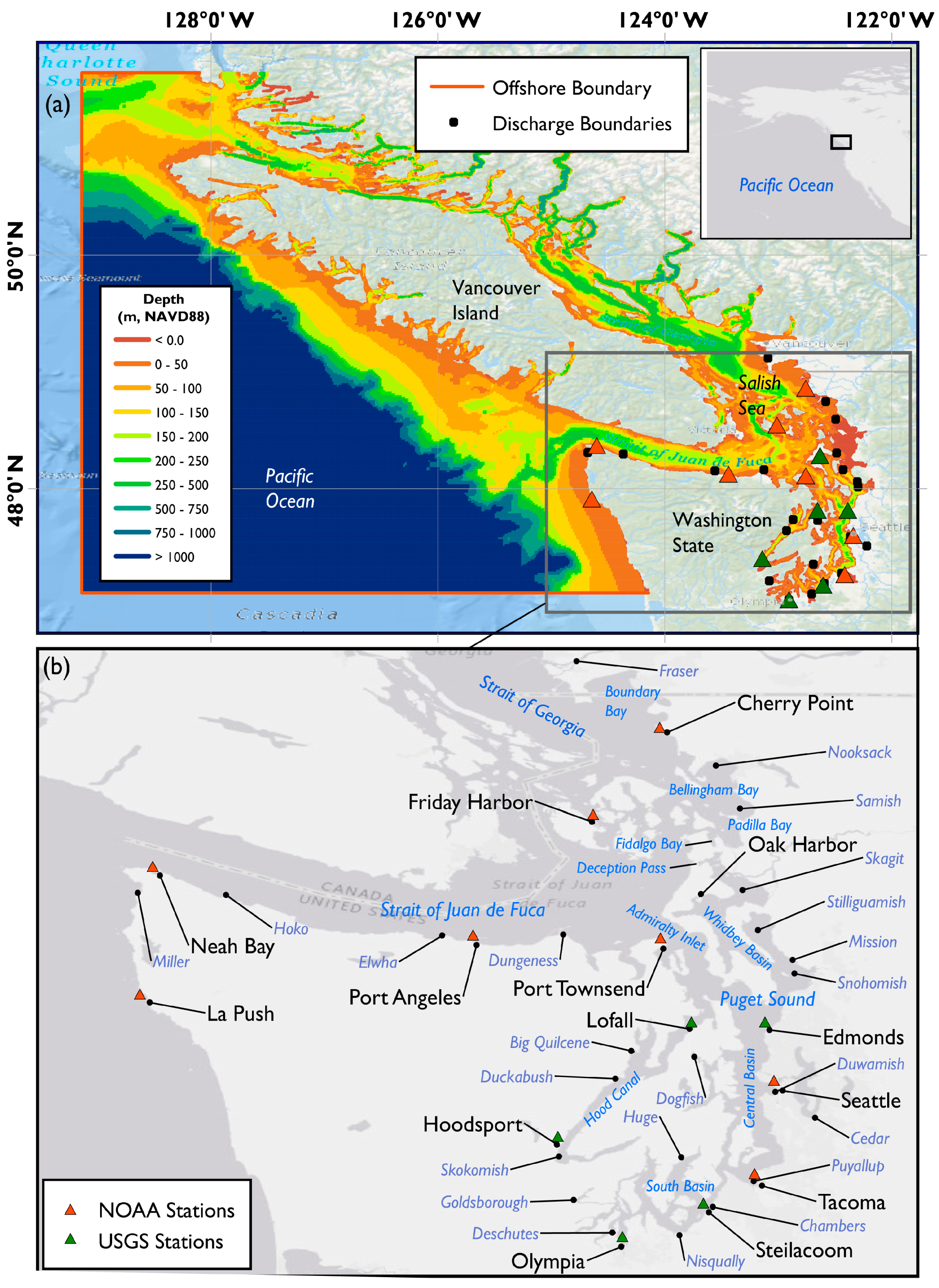

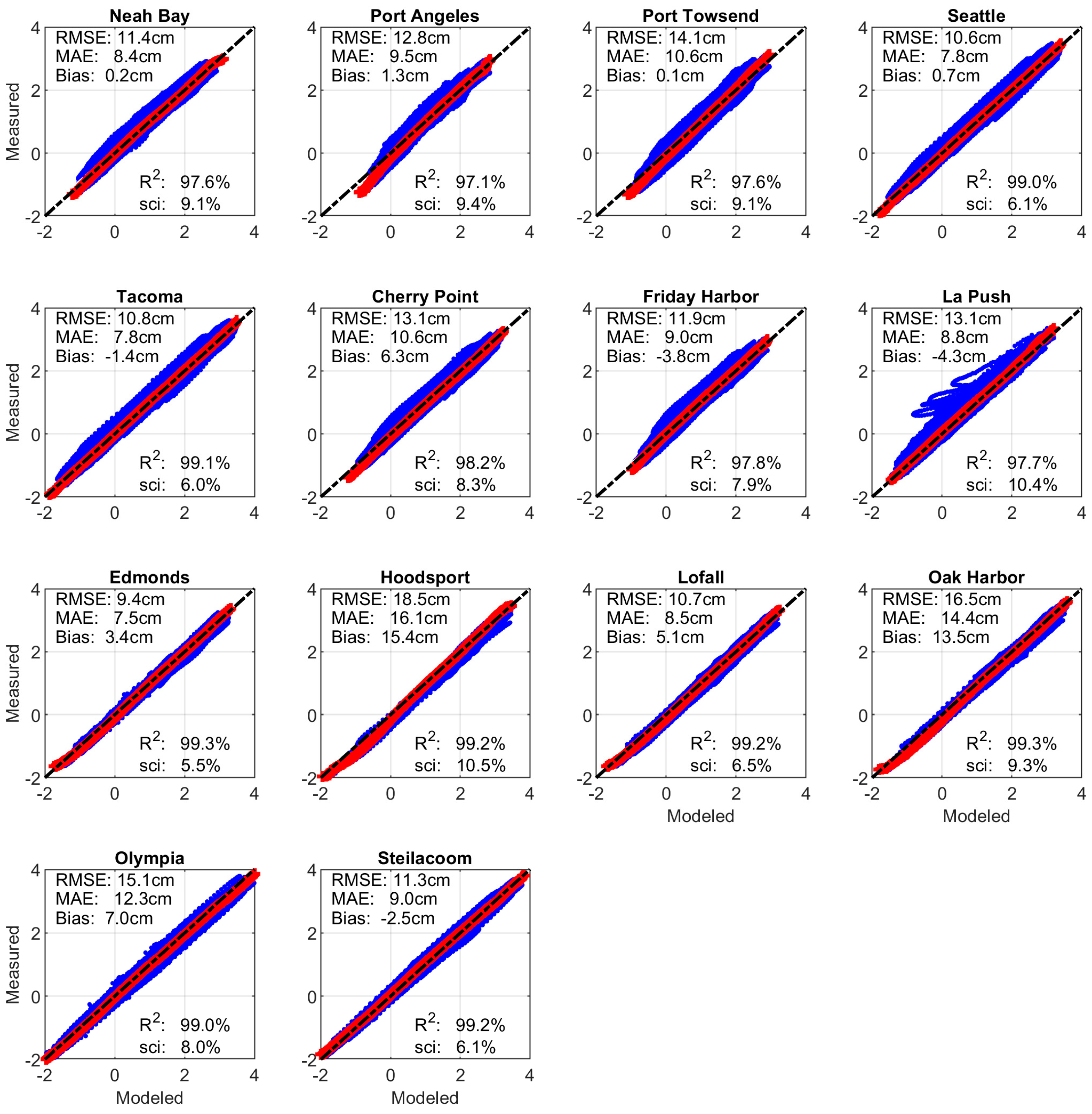



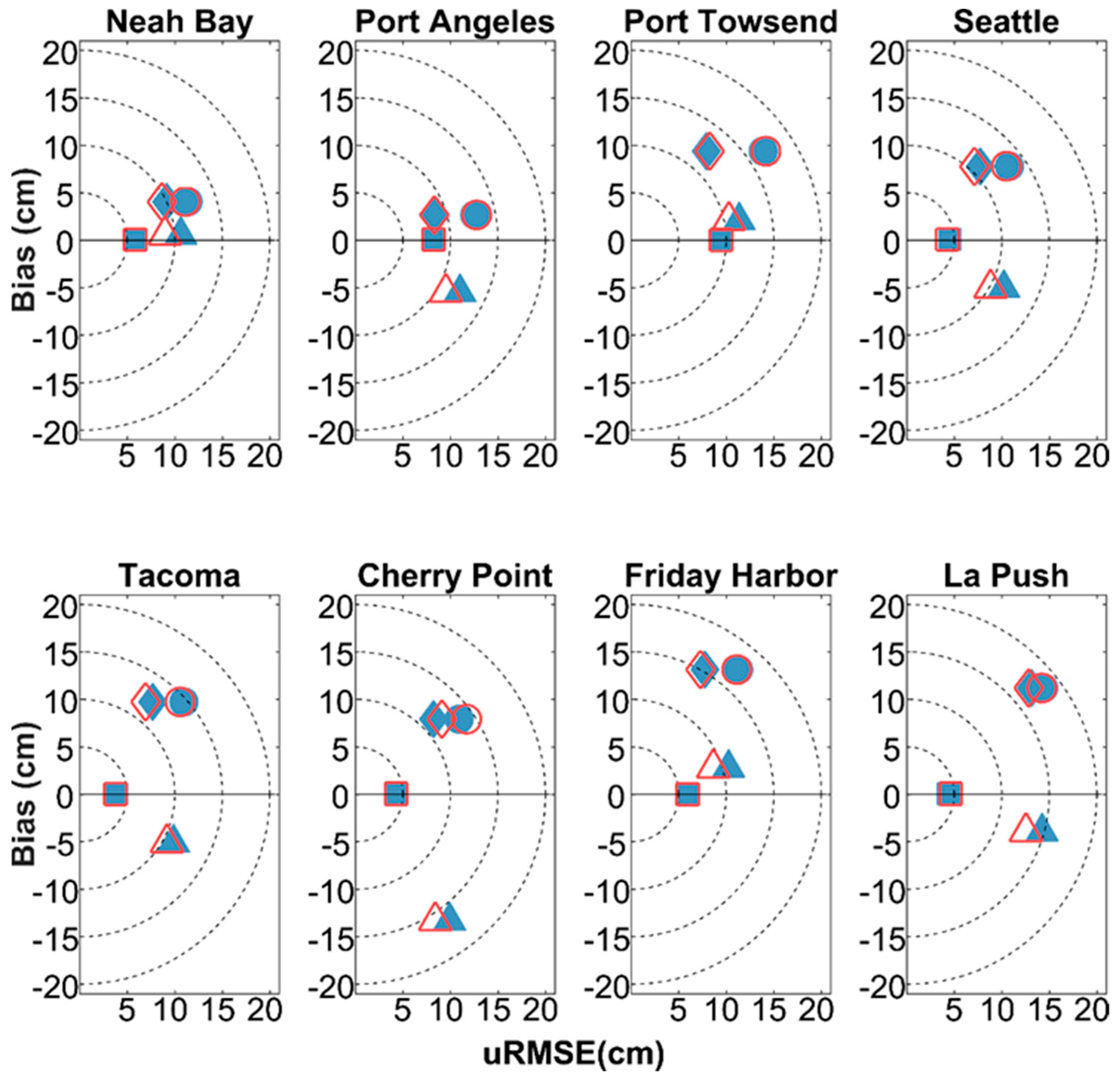
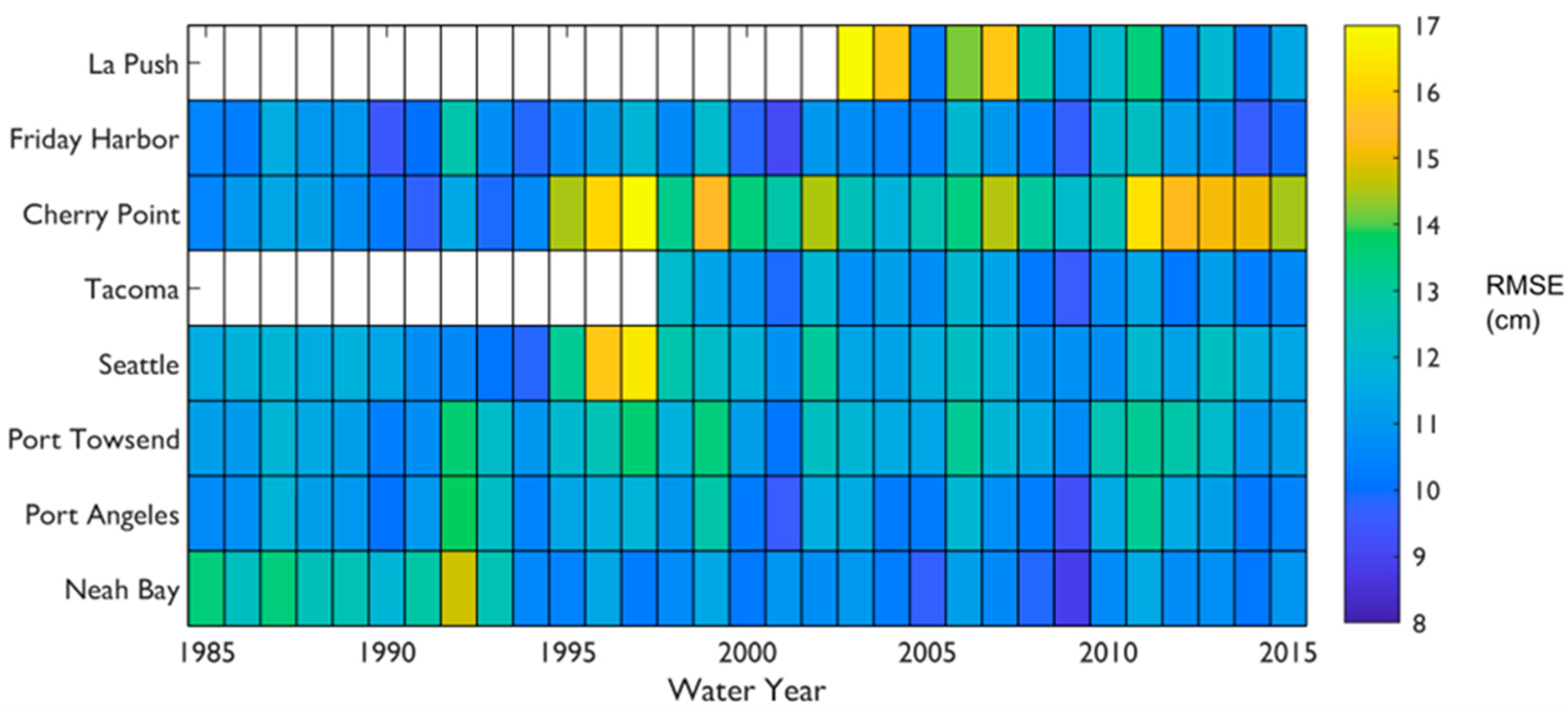




| Model Period | Purpose | Time Frame | SLA | Streamflow | Meteorology | |
|---|---|---|---|---|---|---|
| 1 | Short-term detailed historical period | Determine model skill using the best available data | 2017–2020 | HYCOM | USGS, Environment and Natural Resources Canada ‡ | HRDPS |
| 2 | Long-term historical period | Validate SLA predictor Estimate extremes and contributions | 1985–2015 | HYCOM *; SLA predictor † | USGS, Environment and Natural Resources Canada ‡ | WRF-NARR ‼ |
Disclaimer/Publisher’s Note: The statements, opinions and data contained in all publications are solely those of the individual author(s) and contributor(s) and not of MDPI and/or the editor(s). MDPI and/or the editor(s) disclaim responsibility for any injury to people or property resulting from any ideas, methods, instructions or products referred to in the content. |
© 2023 by the authors. Licensee MDPI, Basel, Switzerland. This article is an open access article distributed under the terms and conditions of the Creative Commons Attribution (CC BY) license (https://creativecommons.org/licenses/by/4.0/).
Share and Cite
Grossman, E.E.; Tehranirad, B.; Nederhoff, C.M.; Crosby, S.C.; Stevens, A.W.; Van Arendonk, N.R.; Nowacki, D.J.; Erikson, L.H.; Barnard, P.L. Modeling Extreme Water Levels in the Salish Sea: The Importance of Including Remote Sea Level Anomalies for Application in Hydrodynamic Simulations. Water 2023, 15, 4167. https://doi.org/10.3390/w15234167
Grossman EE, Tehranirad B, Nederhoff CM, Crosby SC, Stevens AW, Van Arendonk NR, Nowacki DJ, Erikson LH, Barnard PL. Modeling Extreme Water Levels in the Salish Sea: The Importance of Including Remote Sea Level Anomalies for Application in Hydrodynamic Simulations. Water. 2023; 15(23):4167. https://doi.org/10.3390/w15234167
Chicago/Turabian StyleGrossman, Eric E., Babak Tehranirad, Cornelis M. Nederhoff, Sean C. Crosby, Andrew W. Stevens, Nathan R. Van Arendonk, Daniel J. Nowacki, Li H. Erikson, and Patrick L. Barnard. 2023. "Modeling Extreme Water Levels in the Salish Sea: The Importance of Including Remote Sea Level Anomalies for Application in Hydrodynamic Simulations" Water 15, no. 23: 4167. https://doi.org/10.3390/w15234167
APA StyleGrossman, E. E., Tehranirad, B., Nederhoff, C. M., Crosby, S. C., Stevens, A. W., Van Arendonk, N. R., Nowacki, D. J., Erikson, L. H., & Barnard, P. L. (2023). Modeling Extreme Water Levels in the Salish Sea: The Importance of Including Remote Sea Level Anomalies for Application in Hydrodynamic Simulations. Water, 15(23), 4167. https://doi.org/10.3390/w15234167







